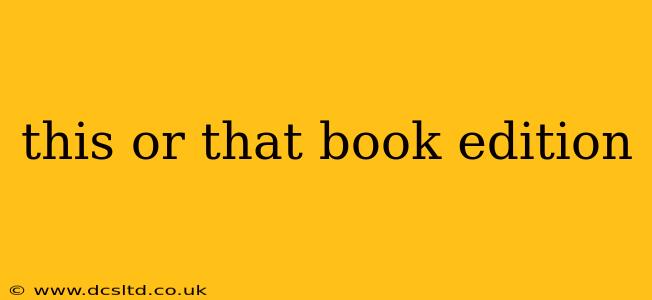This or That Book Edition: Choosing the Right Version for You
Choosing between different editions of a book can feel overwhelming. Whether it's a classic novel, a contemporary bestseller, or a technical manual, understanding the nuances of various editions—mass market, paperback, hardcover, and even special editions—is key to making an informed decision. This guide will help you navigate the world of book editions and choose the perfect version for your needs and preferences.
What are the different types of book editions?
This is a fundamental question that often stumps book lovers. Let's break down the most common types:
-
Mass Market Paperback: These are typically smaller, lighter, and less expensive than trade paperbacks. They're ideal for readers on the go who prioritize affordability and portability. However, the paper quality might be lower, and they may lack features like dust jackets.
-
Trade Paperback: These are larger and often have better-quality paper and binding than mass market paperbacks. They offer a balance between price and quality, making them a popular choice for many readers.
-
Hardcover: Hardcovers usually represent the original, high-quality publication of a book. They often feature superior paper, binding, and dust jackets, creating a more luxurious reading experience. They are usually more expensive than paperback versions.
-
Special Editions: These can include limited editions, signed copies, or editions with unique features like illustrations or different cover art. These editions are often collector's items and can command a significantly higher price.
-
eBook: Digital versions offer convenience, searchability, and adjustability. They're great for readers who prefer electronic devices and are conscious of environmental impact. However, some readers prefer the feel of a physical book.
How do I decide which book edition is right for me?
Choosing the "right" edition depends heavily on your individual priorities:
-
Budget: Mass market paperbacks are the most affordable, while special editions are the most expensive. Trade paperbacks and hardcovers fall somewhere in between.
-
Reading Habits: If you're a frequent traveler or prefer lightweight books, a mass market paperback might be ideal. If you value a high-quality reading experience and plan to keep the book for a long time, a hardcover might be preferable. eBook readers will naturally gravitate towards the digital format.
-
Collectibility: If you're a collector, special editions or first editions will be your focus.
-
Book Condition: When buying used books, it's crucial to check reviews and descriptions for accurate condition assessment.
What are the pros and cons of different book editions?
Let's summarize the advantages and disadvantages of the main edition types:
Mass Market Paperback:
- Pros: Affordable, portable, widely available.
- Cons: Lower paper quality, less durable binding, may lack features like dust jackets.
Trade Paperback:
- Pros: Good balance of price and quality, better paper and binding than mass market.
- Cons: More expensive than mass market paperbacks.
Hardcover:
- Pros: Highest quality paper and binding, often includes a dust jacket, a more luxurious reading experience.
- Cons: Most expensive option.
eBook:
- Pros: Convenient, portable, searchable, adjustable font size, environmentally friendly.
- Cons: Some readers prefer the feel of a physical book; potential for technological issues.
Special Editions:
- Pros: Unique features, collector's item, potential for appreciation in value.
- Cons: Significantly more expensive, may be limited availability.
Where can I find information about different book editions?
Websites like Amazon, Goodreads, and the publisher's website often provide detailed information on available editions, including prices, formats, and special features. Checking multiple sources ensures you're getting the most comprehensive overview.
By carefully considering these factors, you can confidently choose the book edition that best suits your individual preferences and needs. Happy reading!
